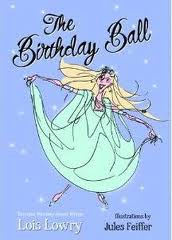 The Birthday Ball
The Birthday Ball is a cute farce of a fairy tale, with sketches by Jules Feiffer (you may recognize his distinctive style from The Phantom Tollbooth) throughout. It’s patently ridiculous, with exaggerated characters—there’s no attempt at realism. Although in most ways it’s a fairly standard princess-story setting, there are throw away lines about spandex and plastic, and the names of all the kingdoms are based on unpleasant medical conditions, so you can’t even quite make solid assumptions about the world.
Princess Patricia Priscilla, four days from her 16th birthday when she will have to choose a suitor, is bored. She decides to dress as a peasant and go to school with the children she can see from her window. The plot is actually rather complex, as we meet the schoolmaster, the princess’ chambermaid, and the three appalling suitors. The story follows each of these threads until you can see them converging toward an explosion at the Birthday Ball. Part of the fun is that the reader can see it coming long before the characters do, so you can giggle in anticipation and wonder how on earth it’s all going to work out. And the threads all get fairly neatly tied off, with more character growth and development in the last chapter than there had been through the rest of the book.
SPOILER ALERT: Things you might want to know before suggesting this to your kid
Family
Lots of comments in passing about awful parents, but the only family relationships we really see are the princess and her parents. They both love their daughter and they mean well, but the king is obsessed with his butterfly collection and the queen is hard of hearing and rather out of touch.
Disabilities
The queen is deaf—a result of severe frostbite due to vanity (she wouldn’t wear her hat) when she was a girl—and mostly this is played for laughs. Of course she always hears something that isn’t quite what people were saying. However, the book also makes a point of demonstrating how she has learned to deal with her disability with grace. Each of the awful suitors has some kind of issue—one is very ugly to the point where he seems to be disfigured, one (two?) is a set of conjoined twins who fight all the time, and the other has a case of severe dandruff and some hygiene and style issues. The last is pretty much an awful person, and he isn’t redeemed in the end. The other two (three?) show significant growth by the end and are finding acceptance in ways they’d never experienced before
Class
The various plots end up dealing with the expectations and assumptions of the various classes. The nobles have plenty of unreasonable demands—especially the suitors. The princess doesn’t hesitate to give commands, even after realizing how hard it is to be on the receiving end of a command when she goes to the village school. To some extent, I appreciated that a few days as a peasant didn’t suddenly make her completely egalitarian. She does learn that many of her assumptions about the peasants were wrong, but she simply takes this in stride, adjusting her ideas as she goes. In the end, the queen knights the schoolmaster—that’s all it takes to go from peasant to noble, so they obviously don’t have a lot of problems with upward mobility even if they demand that the princess must marry a noble.
Sexism
There’s some assumed sexism in the setting—only a few girls become teachers, the princess’ only responsibility is to choose a suitor and produce an heir, the chambermaid was thrown out of the house by her pa because girls are useless. The book quietly proves each of these assumptions wrong as the chambermaid does quite well for herself and the princess decides to learn to be a teacher (as well as a princess) instead of strictly following the path laid out for her.
Recommendation
I was a little uncomfortable at first about the various disabilities played for laughs, but because most of those characters grew and became sympathetic by the end, I wasn’t as bothered once I’d read the whole book. If this is something you or your child is sensitive about, however, it may be hard to put up with. Overall the story is cute and ridiculous; it’s a fine read for maybe 8 to 11. There are some pretty big words for young or reluctant readers, but with fairly large type and many illustrations, it’s not too intimidating.
The Birthday Ball by Lois Lowry
Published in 2010 by Houghton Mifflin
Read my daughter’s copy





Speak Your Mind